Cite this document
(The Fundamentals of Business Contract Law in the United Kingdom Assignment, n.d.)
The Fundamentals of Business Contract Law in the United Kingdom Assignment. https://studentshare.org/law/1710615-contract-law
The Fundamentals of Business Contract Law in the United Kingdom Assignment. https://studentshare.org/law/1710615-contract-law
(The Fundamentals of Business Contract Law in the United Kingdom Assignment)
The Fundamentals of Business Contract Law in the United Kingdom Assignment. https://studentshare.org/law/1710615-contract-law.
The Fundamentals of Business Contract Law in the United Kingdom Assignment. https://studentshare.org/law/1710615-contract-law.
“The Fundamentals of Business Contract Law in the United Kingdom Assignment”. https://studentshare.org/law/1710615-contract-law.


